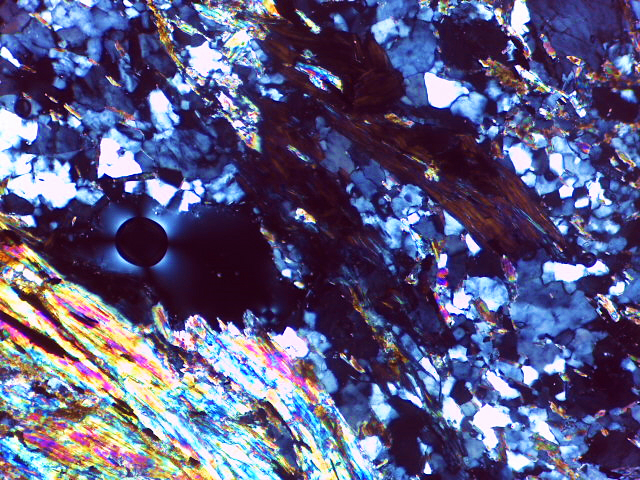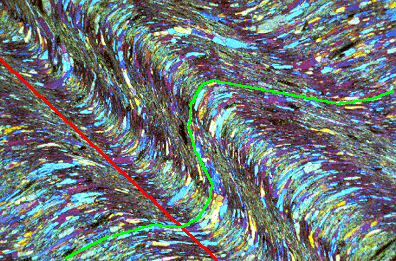Students unlock the secrets of the region’s geology
By Stephanie Widzowski
Mineralogy, one of the four 200-level major requirements for geology students, has been taught in a myriad of ways – some more successful than others. Professor Selby Cull-Hearth has tried everything from lectures to a life-like research experience. She works hard to create the best environment for students every year.
She refuses to assign a textbook because none of them explain mineralogy well enough. So she writes her own chapters on Microsoft Word, draws her own figures, and uploads them all to Moodle.
This year class time is entirely for the students. Need to study for the next exam? Pore over the readings or work with someone else to quiz the concepts. Test your memory with optional Moodle quizzes or get familiar with a tray of minerals in the back of the classroom.
All the deadlines are listed on Google Sheets files Cull-Hearth made, and all students have to do is fill their box in green after finishing something. It’s collaborative, so people can see where others are stuck and offer a hand.Cull-Hearth is there to help too, but students often depend on each other more.
Final exams and papers are standard, but this final is neither.
The class is putting together something the whole Bi-Co can enjoy: an exhibit to go in the long-empty display cases in Park Science Building. It will tell the geologic story of Philadelphia and the evidence behind it.
“The best way to know what you know is by explaining things to others,” said Cull-Hearth.
But telling the entire geologic story of the region, a history over a billion years old? Where should a handful of undergraduate students start? And what does mineralogy have to do with it?
Scholars like Howard Bosbyshell have spent decades studying the region and published papers on their work. To start, each person in the class picked a local rock unit and scanned the articles for any mention of it, trying to figure out the age of the rock and how the experts think it formed.

The major rock units being studied and where they meet the Earth’s surface. Cull-Hearth.
There’s still a lot of uncertainty about the rocks in this region. For one, there are hardly any exposures that aren’t covered in plants or weathered by rain, and getting funding to excavate rock is near impossible.
For the sites geologists can access, not all rock can be dated. That requires elements that decay radioactively over time, which are rare. (Carbon-14 is common, but that’s only good for 10,000 years or so.) Even when it can be dated, often what’s recorded is the age of mountain building when the unit was deformed, not its original age. So scientists and geology students alike do their best with the information they have, and constantly try to get more.
Reading the literature is only a prelude for the main event – the signature of all geology courses – the field trip and following report.
Saturday at 6 a.m. sharp, the geology department vans revved their engines as sleepy students packed in. They were named Betty and Bascom and had labels next to their license plates. They sailed through misty back roads on their way north into the Honey Brook Upland, where an exposure of rock about a billion years old lay on a road cut.
The department has a saying on field trips: “Put your nose to the rock.” That’s exactly what 15 students did, field notebooks and rock hammers in hand. No one dared back into the road with the occasional truck barreling by.

Mineralogy students “putting their noses to the rock”. Photo taken at Mt. Airy.
Knowing what minerals are at any given stop is important. You may remember the three types of rocks – igneous, sedimentary, and metamorphic.
Igneous rocks form from magma or lava, sedimentary rocks form from grains of other rocks, and metamorphic rocks are ones transformed by heat and pressure. Certain minerals are more likely to appear in different types. For example, kyanite, staurolite, andalusite and sillimanite only grow in metamorphic rocks, and which ones grow depend on the heat and pressure. So, geologists can tell how extreme conditions were at any given site just by looking at the minerals.
Continental collsions tend to get pretty extreme. The rock at Honey Brook Upland had bands of enormous crystals. The banding is a sign of metamorphism, and the larger the crystals are, the longer the rock took to cool.
“This was almost a migmatite,” said Cull-Hearth, indicating the rock was so hot while it was being compressed that it almost melted. This was almost definitely a result of an old supercontinent called Rodinia coming together about 900 million years ago. But this was only the first stop of the field trip, and there was still a lot of rock between here and Philadelphia. Where was evidence of Pangea, the supercontinent that began to break up 175 million years ago?
Younger continental collisions were recorded in rock closer to the coast, as that land attached to the side of North America much later. Minerals once again come in handy
. Small staurolites were found at a stop far from Philadelphia. Closer to the city in the same unit, the staurolites were giant – sometimes an inch long. Even closer, and suddenly they disappeared.
Here’s the interpretation: staurolite is stable at moderate temperatures, so the rocks heated up closer to present-day Philadelphia until they were so hot that staurolite broke down. That’s a sign that the collision was happening on the border. This younger event is most likely evidence of Pangea.
At each stop, someone was responsible for collecting a sample. They would spend the rest of the semester turning that sample into a thin section to put under a microscope.
The process is long and grueling. Take a trip down to the rock room in the basement of Park, and you’ll see a lab like no other. Every surface is covered in clay. The equipment is closer to what you would expect from a workshop.
First, the rock is cut under a saw. Igneous and metamorphic rocks are pretty hard, but this saw is coated in diamond dust and makes short work of any sample. Once someone has a small rectangle or “billet” of rock, it gets polished into a perfectly flat surface that will be glued onto a glass slide. The billet then gets ground down from the non-glass side until the thinnest layer of rock is left. Finally, a cover slide is glued on top. The result: a glass-rock-glass sandwich thin enough to shoot light through.
Rocks, can be seen below, look spectacular under a microscope.

There are hundreds of thousands of minerals, and many look alike to the naked eye. Mineralogists rely on a handful of tricks to tell them apart under a lens. Why is this important? Each mineral forms in a slightly different environment. We can use them to tell what Earth was like in the past.
Minerals also hide crucial details – alignment, deformities – that are evidence of events through Earth’s history. Understanding the big picture can start smaller than the eye could ever see.
To cement their understanding of the science, the class met with one of the experts whose papers gave the foundation. This information is Bosbyshell-verified.

In this thin section (seen above) the rock has been deformed at least twice – once to make the original sheets of mica and again to fold them. This pattern is called crenulation cleavage.
The science is important, but it does no good unless the public can follow it. That’s why faculty from the museum studies department gave a talk to the mineralogy class with tips for making the best exhibits.
“You need to give the reader ownership over their own education,” said Carrie Robbins of Special Collections.
Cull-Hearth has also been working on her own exhibits and used them as an example. The title: Poison Paints. It’s the story of how the most iconic pigments in art are often made from deadly minerals. An interesting theme, catchy title, colorful minerals, and a bright backsplash – Starry Night, by Van Gogh – are all vital. Making an exhibit is as much art as it is science.
Each placard has at most 70 words. Boiling down the entire geologic history to a few hundred words is going to take a lot of work.
To help gather ideas, Cull-Hearth arranged for the class to meet with curators at the Washington D.C. Smithsonian Museum. Another field trip!
The vans left the Wawa parking lot after a short breakfast and joined rush-hour traffic on the ramp to I-95. Cristian Clothier, a senior student and second driver, floored the gas pedal of Betty as soon as he got a chance, prompting screams from the back. Despite his best efforts, Bascom disappeared from view in front of a truck.
“This is my contribution to the class,” said Abby Harrison, pulling out her phone to get directions to the Smithsonian.
A large part of the Smithsonian’s success with their mineral exhibits are the size and quality of the gems. It’s hard to compare to a world-class museum, but Bryn Mawr does have a vast collection of minerals. The writing will just have to be as clear and informative as possible.
Finally, it was time to get to work making the exhibits. The class created a sign-up sheet to decide who would work on what. The background poster had to be designed, minerals from the collection had to be chosen, and the story had to be written, among other things.
Under field trip photos, someone had written “I volunteer Abby as tribute”. Harrison is a professional photographer and her skills come in handy. Katie Billings, another student, is a talented graphic designer. It seemed everyone was suited for a role.
Michelle Luu and Elizabeth Yost sorted through samples everyone had collected from the trip and polished them on a special machine. At the same time, Billings was working with Harrison and a senior named Ankitha Kannad on diagrams. The three disagreed on how to present the information.
“Not everybody is a visual learner,” said Harrison.
“Because we’re in an academic building and not a museum, I don’t think many people will stop and read the paragraphs,” said Billings.
Two other classmates, Elizabeth McGuire and Alexis Pecknay, were writing the story.
“Mostly I write something and then Alexis deletes it and fixes it,” McGuire laughed.
“We’re both contributing material and writing,” said Pecknay. She knows a lot about the Octoraro formation because it was her unit. “But for the other ones, we’re reading the entries other people have written and trying to put it into layman’s terms.”
“This thin section has a lot of weird shit,” said Clothier. He was scanning through thin sections, identifying minerals, and taking pictures of them to upload to Pinterest.
One morning, Cull-Hearth greeted the class with bad news: the display cases that were meant to be installed at the end of the semester wouldn’t come in until winter break at least. The class would end and the exhibit wouldn’t be ready for viewing. What was all this work for?
“But,” added Selby, “we might be able to throw an installation party early next semester.”
There is definitely a need to make exhibits like this, according to Billings.
“I had someone ask me if Pangea broke up because of the meteor that killed the dinosaurs,” she said. That seems far-fetched, but people might not know that without taking geology courses.
Studying goes on as usual in Park, but one class holds its breath for the day when the hallways glitter with minerals. Next semester, watch for the Philadelphia (Geologic) Story and the mark of dedicated students.
